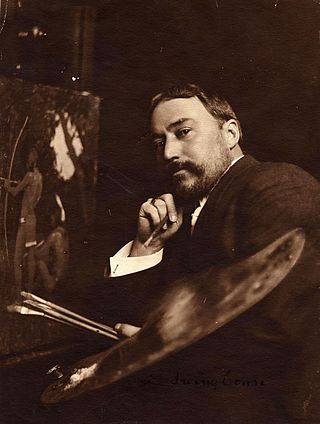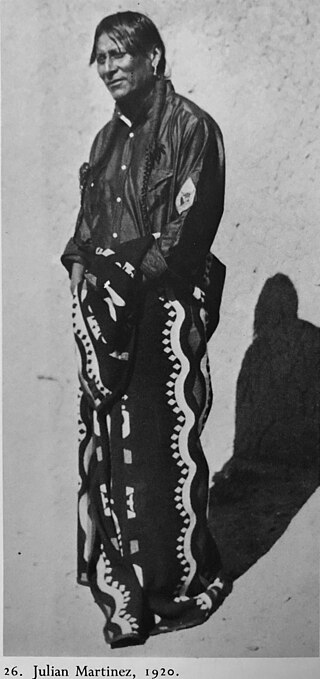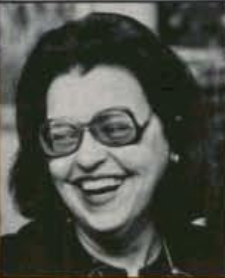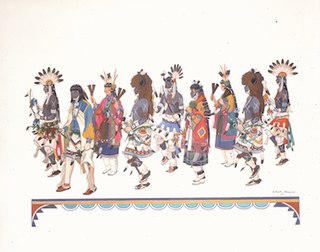
The Taos art colony was an art colony founded in Taos, New Mexico, by artists attracted by the culture of the Taos Pueblo and northern New Mexico. The history of Hispanic craftsmanship in furniture, tin work, and other mediums also played a role in creating a multicultural tradition of art in the area.

Eanger Irving Couse was an American artist and a founding member and first president of the Taos Society of Artists. Born and reared in Saginaw, Michigan, he went to New York City and Paris to study art. While spending summers in Taos, New Mexico, he began to make the paintings of Native Americans, New Mexico, and the American Southwest for which he is best known. He later settled full time in Taos.

Nampeyo was a Hopi-Tewa potter who lived on the Hopi Reservation in Arizona. Her Tewa name was also spelled Num-pa-yu, meaning "snake that does not bite". Her name is also cited as "Nung-beh-yong," Tewa for Sand Snake.

Albert Lorey Groll (1866–1952) was an American artist and etcher. He was born in New York City and studied at the Academy of Fine Arts in Munich, Germany, the Royal Academy in Antwerp, Belgium, and for some time in London. In 1910 he was elected into the National Academy of Design. He is best known for his landscape paintings of the American Southwest.

Julián Martínez, also known as Pocano (1879–1943), was a San Ildefonso Pueblo potter, painter, and the patriarch of a family of Native American ceramic artists in the United States.

Pop Chalee, also known as Merina Lujan, was an American painter, muralist, performer, and singer. In 2021, she was inducted into the National Cowgirl Museum and Hall of Fame.

The Millicent Rogers Museum is an art museum in Taos, New Mexico, founded in 1956 by the family of Millicent Rogers. Initially the artworks were from the multi-cultural collections of Millicent Rogers and her mother, Mary B. Rogers, who donated many of the first pieces of Taos Pueblo art. In the 1980s, the museum was the first cultural organization in New Mexico to offer a comprehensive collection of Hispanic art.
Albert Looking Elk, also known as Albert Martinez was a Taos Pueblo painter. Looking Elk is one of the three Taos Pueblo Painters.
Albert Lujan (1892–1948), also known as Xenaiua meaning "Weasel Arrow," was a genre and landscape painter from Taos Pueblo, New Mexico.
Juan Mirabal, also known as "Tapaiu" or Red Dancer, was an artist from Taos Pueblo, New Mexico.
Native American women in the arts are women who are from Indigenous peoples from what is now the mainland United States who are visual art professionals. Women in Native American communities have been producing art intertwined with spirituality, life, and beauty for centuries. Women have worked to produce traditional art, passing these crafts down generation by generation, as well as contemporary art in the form of photography, printmaking, and performance art.

Art of the American Southwest is the visual arts of the Southwestern United States. This region encompasses Arizona, New Mexico, and parts of California, Colorado, Nevada, Texas, and Utah. These arts include architecture, ceramics, drawing, filmmaking, painting, photography, sculpture, printmaking, and other media, ranging from the ancient past to the contemporary arts of the present day.

Anna Miller Corbell (1896–1993) was an early 20th century American artist, known for her panoramic landscape paintings of the American Southwest. Corbell was active as a painter for over thirty years. Her subject matter largely consisted of the Southwestern desert with mountain views. Describing herself as "not a modern painter," she worked in a palette of pastel hues to capture the colors and light of the Arizona desert.

Valjean McCarty Hessing was a Choctaw painter, who worked in the Bacone flatstyle. Throughout her career, she won 9- awards for her work and was designated a Master Artist by the Five Civilized Tribes Museum in 1976. Her artworks are in collections of the Heard Museum of Phoenix, Arizona; the Philbrook Museum of Art in Tulsa, Oklahoma; the Southern Plains Indian Museum in Anadarko, Oklahoma; and the Wheelwright Museum of the American Indian of Santa Fe, New Mexico, among others.
Susan Folwell is a Native American artist from Santa Clara Pueblo, New Mexico, known for her work in the ceramic industry. Her work ties in Native designs and history and has been used by Folwell to demonstrate her viewpoints on society and politics. Folwell has been described by the Heard Museum as an "innovator in Pueblo pottery".
Romando Vigil, also known as Tse Ye Mu was a Native American self-taught painter and a leader in the San Ildefonso school. He briefly worked for Walt Disney Studios as a painter and illustrator in the 1950s.

José Vicente Aguilar, also called Sua Peen, is a Pueblo-American painter of San Ildefonso Pueblo and Picurís Pueblo heritage. He is known for his watercolor paintings. Aguilar has exhibited across the United States, particularly in the Southwest, and his work is in the permanent collection of institutions including the Gilcrease Museum.

Gilbert Benjamin Atencio, also called Wah Peen, was a San Ildefonso Pueblo painter, potter, medical Illustrator, and politician.

Robert Chee, also known as Hashke-Yil-Cale (1937–1971) was a Navajo contemporary artist and author. He is best known for his painting and serigraphy, but he also worked as an illustrator, and weaver.













